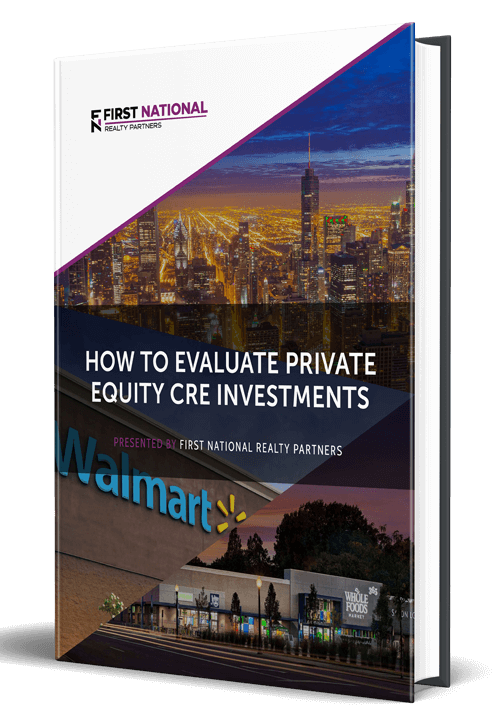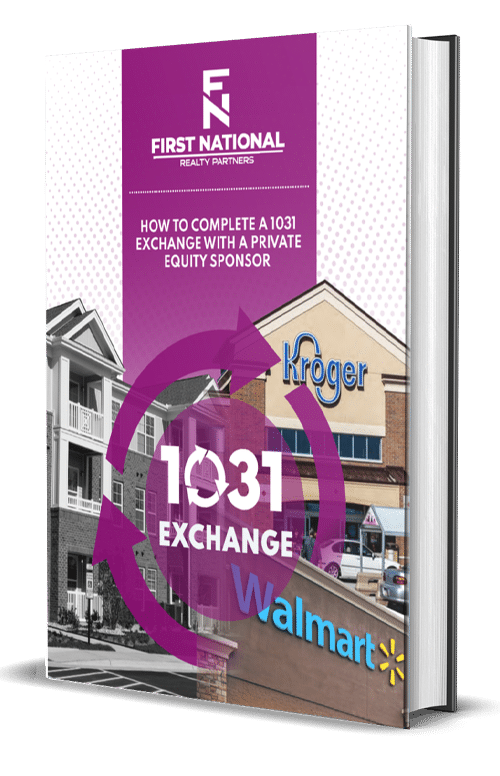A property’s capitalization rate – cap rate for short – is an investment analysis metric that helps real estate investors understand the risk/return profile of a deal. Although the formula used to calculate the cap rate is quite simple, the inputs and the expression of it can occasionally be a bit murky. This post aims to make it clearer.
In this article, we will define what a cap rate is, how it is calculated, how to figure out the “implied cap rate” if it isn’t explicitly expressed, and why it is so important. By the end, readers will be able to incorporate this knowledge into their real estate investment screening and due diligence processes.
At First National Realty Partners, we have a saying that we look at 100 deals and choose just one to invest in. One of the ways that we filter through this volume of deals is by using the cap rate as a barometer to identify the most profitable deals for our investors. If you are an accredited investor and would like to learn more about our current commercial real estate investment opportunities, click here.
What is The Implied Cap Rate?
In order to understand what the implied cap rate is, it is first important to understand what the cap rate is and how it is calculated.
The cap rate is a commercial real estate investment performance metric that describes the annual investment return assuming a property was purchased in cash. Because return is correlated with risk, it can also signal the amount of risk in a deal. The higher the cap rate, the more potential risk.
The cap rate calculation formula is net operating income divided by purchase price/property value. For example, if a property has $100,000 in Net Operating Income and a purchase price of $1,000,000, the cap rate is 10%.
But, the issue for investors is that deals are not always presented in this way. Sometimes the cap rate is not explicitly stated. When it isn’t, the above math must be done to figure out the implied cap rate, that is to say the cap rate that is suggested by the numbers provided.
How to Calculate The Implied Cap Rate
To calculate the implied cap rate, the above two variables are needed, net operating income and property value/purchase price. These aren’t always explicitly provided either, so it makes sense to understand how these variables are derived.
Net operating income (NOI) is calculated as a property’s gross income less its operating expenses. So, this value can be derived from looking at a property’s income statement.
Property value/purchase price is simply the value of the property. This could be derived from a purchase price, asking price, appraised market value, or simply an investor’s best estimate of value.
Like the cap rate, the implied cap rate formula is net operating income divided by purchase price/property value. To illustrate how the implied cap rate calculation works, suppose that a real estate investor is handed a deal where the property produces $187,000 in NOI annually and has a purchase price of $2.3M. The implied cap rate in this deal is 8.13%.
Why The Implied Cap Rate Is Important
There are four reasons why identifying the implied cap rate is important in commercial real estate:
1. Returns
Again, the implied cap rate provides commercial real estate investors with an indication of their annual rate of return on investment.
2. Market Perception of Risk
The market’s assignment of value to a property provides a signal about risk. Higher cap rates/lower sales price means that the property has more risk. A lower cap rate/higher valuation means that the property has lower risk.
3. Filter Deals
For investors who look at dozens or hundreds of commercial real estate investment deals to find one they like, the cap rate can be a good filter. Meaning, they could quickly calculate the implied cap rate and if it doesn’t fall within a desired range, they could make an investment decision to pass on the deal.
4. Comparing Properties
Finally, since the cap rate is easy to calculate, it is a good way to compare similar properties. For example, if there are two multifamily apartment buildings that are similar in every way except one has a cap rate of 7% while the other has a cap rate of 5%, an investor could immediately determine that there is something about the property with the higher cap rate that makes it less expensive. Perhaps the roof is in bad condition or the income stream is unreliable.
While the cap rate is an important measure of return, it isn’t perfect. Potential real estate investors should be aware of its shortcomings.
Problems with The Implied Cap Rate
There are two notable issues with the implied cap rate in commercial real estate.
First, it relies on estimates. Often, the net operating income used to calculate implied cap rate is not the “in place” NOI. Instead it is the “pro forma” NOI, which is the NOI that could be achieved based on market dynamics.
The second issue is that value is not an objective measure. One commercial real estate investor may look at an investment property and assign it a lower cap rate/higher value while another may come in with slightly different assumptions and assign it a higher cap rate/lower value.
For these reasons, the cap rate associated with a commercial property should not be taken as fact. It is directional and highly subject to change based on real estate market factors, property types, investor assumptions, and current demand.
What is a Good Cap Rate?
The cap rate can vary widely based on the specifics of a commercial real estate deal. But, for context, most commercial properties are bought/sold in the 4% – 12% cap rate range. Of course, a property could command a value outside of this range, but it would be the exception, not the norm.
Investing Through Private Equity Real Estate
The cap rate is just one of many real estate investment performance metrics that must be calculated as part of the pre-purchase due diligence and research process. In our own case, we calculate dozens of performance metrics in addition to reviewing qualitative factors like market conditions, tenant strength, location, and property condition. This amount of research can be a lot for any individual investor to perform.
For this reason, it can be helpful for individual investors to partner with private equity firms when looking to deploy capital into commercial real estate (CRE) assets. Private equity firms are companies who invest in the equity of other privately held companies – including those that own real estate and they can provide a turnkey solution for individual accredited investors who are looking for exposure to this asset class. They do all of the hard work of finding, analyzing, financing, and managing commercial properties and all investors have to do is provide capital.
Summary & Conclusion
In commercial real estate, the capitalization rate is a performance metric that provides investors with information about a property’s potential return.
The cap rate formula is net operating income divided by the property’s current market value.
When the cap rate isn’t explicitly defined in an investment’s marketing materials, investors may have to calculate the implied cap rate using the formula above.
The implied cap rate is important because it gives investors information about risk and return. In addition, it can act as a way to filter through a large volume of real estate deals and can be a useful way to compare two properties to each other.
But, it is also important to remember that the implied cap rate has shortcomings as well. It relies on estimates about things that will happen in the future and there is some degree of subjectivity to it.
Interested In Learning More?
First National Realty Partners is one of the country’s leading private equity commercial real estate investment firms. With an intentional focus on finding world-class, multi-tenanted assets well below intrinsic value, we seek to create superior long-term, risk-adjusted returns for our investors while creating strong economic assets for the communities we invest in.
If you would like to learn more about our commercial real estate investment opportunities, contact us at (800) 605-4966 or info@fnrpusa.com for more information.






